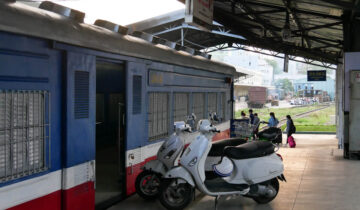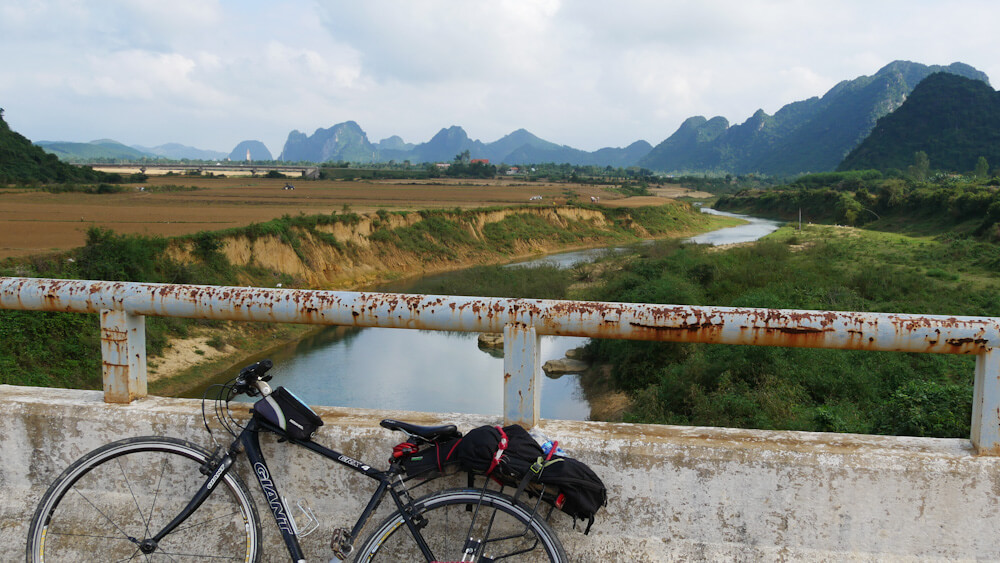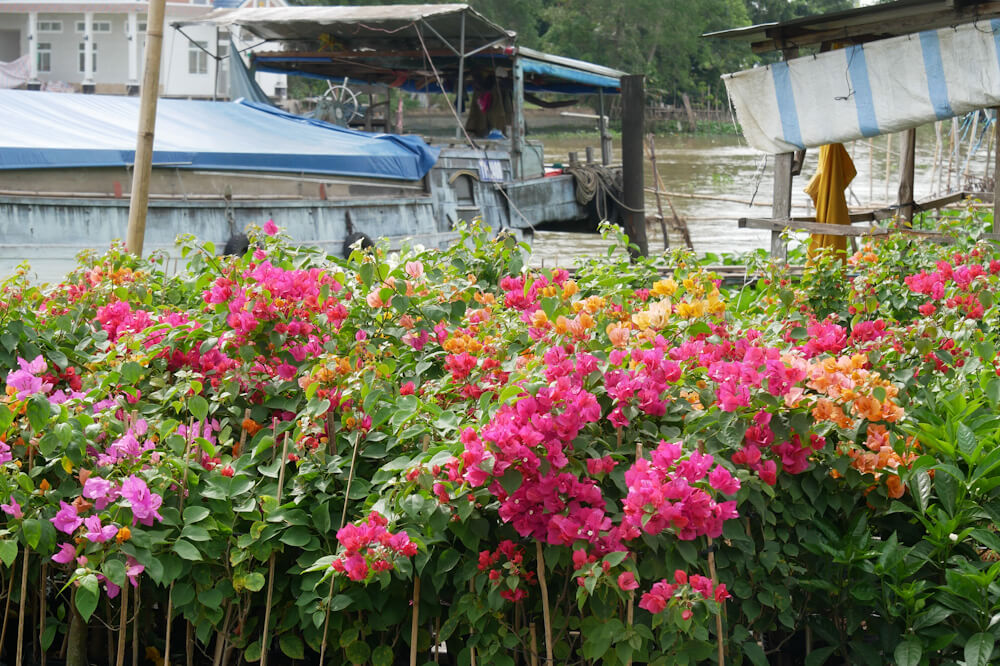Desert vibes abound as the route passes empty beaches and majestic sand dunes – a swathe of genuine desert little known outside Vietnam.
Very few road trippers choose to travel Vietnam’s south coast, choosing instead to travel through Vietnam’s interior via Da Lat. However this would mean missing out on the visually stunning and very different experience that is a ride through Vietnam’s own mini-desert.

The highlight is more than 40 kilometres of road through striking white and red sand dunes. It’s a landscape tailor made for photos that will have friends at home scratching their heads (which country were you in again?). Or at the very least add a whole new layer of variety to your Vietnam cycle tour.
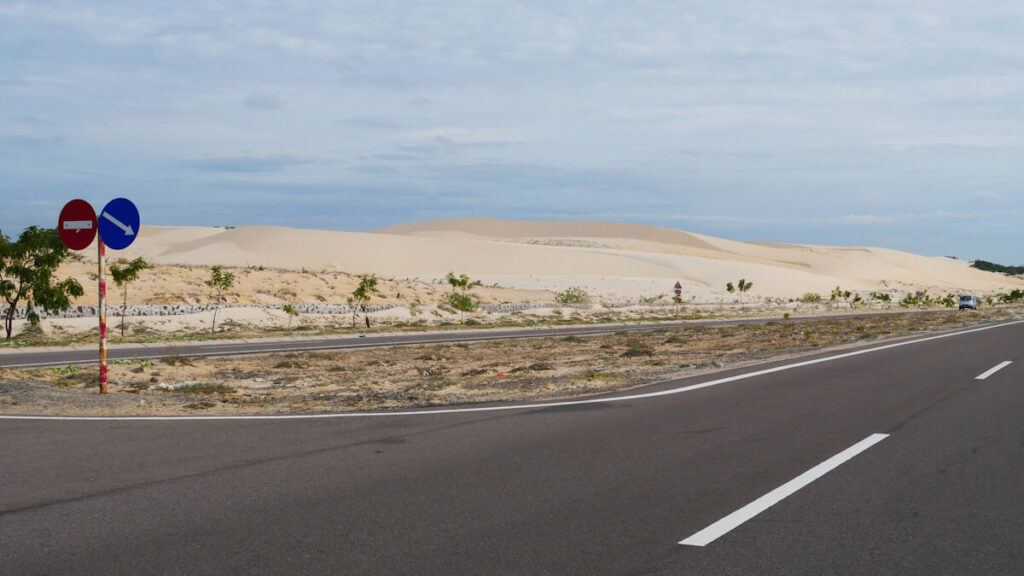
It’s possible to end this route at either Mui Ne or (ten kilometres further) at the main regional capital Phan Thiet. There are pros and cons to both (check out my post on staying in Phan Thiet here). I
In Phan Thiet there is a useful train connection through to Saigon. one of the few train services in Vietnam where you can travel on the same train with your bicycle.
Staying a couple of nights in Mui Ne will allow more time and energy for visiting some of the tourist sights and perhaps winding down at an budget resort with a swimming pool.
Outside of the town traffic should be light or non-existent for this ride, which also passes through coastal forest and right along a long, empty beach .
Prepare for extremely hot conditions with very little shade, at any time of year. Luckily more rest stops have popped up in recent years (complete with hammocks and Instagram props) catering to the new generation of trendy Vietnamese road trippers.

Cycle Touring Route: Co Thach to Mui Ne
Leaving Co Thach you’ll pass through the tiny, picturesque but very poor Binh Thanh, the main population centre and fishing village for the peninsula.
Its worth stopping here to look at the small temple and admire the sight of hundreds of fishing coracles out on the water. In fact, this is a much nicer place to do these things than touristy Mui Ne.
Ten kilometres of flat, quiet road take you through to the next town, passing casuarina forest (sadly marred by litter) and seafood shacks. Eventually forests recede and the road hugs the sea.
There’s a long strip of white sand beach here, though like many fishing beaches in Vietnam this is likely to have a lot of trash. If the weather is hot enough (and it probably will be) its easy to find a nice enough spot to cool off for a swim.

A word of warning about next stretch of road between Chi Cong and Phan Ri Cua. At the time I passed through (in 2018) this road carried some of the worst illegal rubbish dumping I’ve ever seen – anywhere.
I really hope this has since been improved but clearly the local authorities had seriously let down the community here. It was really a shame because, without the rubbish, this would be a very pleasant ride through sandy Casuarina forest.
Phan Ri Cua town
A small town centred around fishing, the traffic in Phan Ri Cua is a good place to stop for lunch. Its streets are surprisingly busy, or at least may seem that way after the deserted coast road.
There is a huge Co-op mart supermarket and various cafes and eateries along Ly Thuong Kiet as you come into town.
To take a break from the blazing sun I took a walk through the local market and it had all the energy of a stock exchange – I loved it. To take a break from the bike I also wandered through some of the narrow, twisting lanes around the waterfront, enjoying the ‘land-that-time-forgot’ feeling.
The Sand Dunes highway
Leaving Phan Ri Cua the landscape becomes arid and quickly transitions to desert. The terrain here also becomes reasonably hilly, with a steep incline that rewards you with a pretty good view. Welcome to the sand dunes highway!

DT716 is a wide, smooth, four-lane highway through that was eerily devoid of traffic when I came through, though it may well get busier on weekends.
The dunes range from orange to yellow to ghostly white. The smooth ripples of these dunes are far less disturbed by tourism than the main tourist sites close to Mui Ne, and there’s something deeply enjoyable about riding here. That said there has been a marked increase in domestic tourism along this road.
You will see surprisingly few foreigners. And there’s a very good reason for that, being the police patrols which for many years have cracking down foreigners riding motorbikes without a Vietnamese license.
On a bicycle, of course, you can just sail on through without a care in the world!
The White Sand Dunes
A final long ascent and descent brings you to the marvellous sight of lake Bau Trang nestled amongst the sand dunes. This is the “White Sand Dunes”, one of the key tourist attractions for day trippers out of Mui Ne.
The dunes get very busy at sunrise and sunset (mainly sunrise) and should be peaceful at other times. For me, the best part of the experience was the view from the road. Walking on foot up the dunes is incredibly energy-sapping, unless you go to the extravagance of hiring a jeep.
There are a couple of viewpoints and Cafe Dream Bay looks like a nice place to stop for a drink.
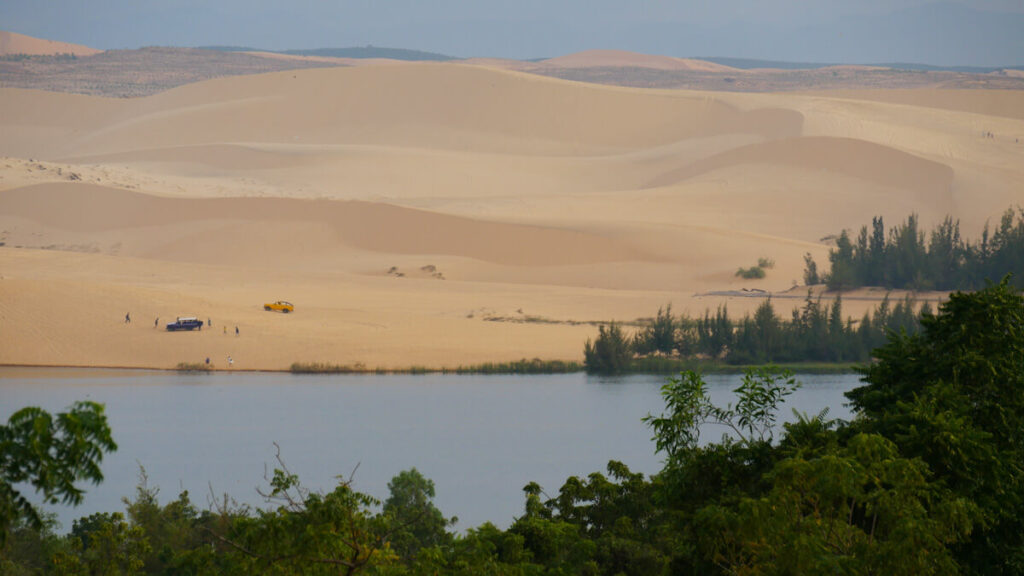
Red Sand Dunes
Just before Mui Ne you’ll take a turn off onto a smaller road skirting the northern end of Mui Ne town. And just before that turn-off sits the Red Sand Dunes site, smaller of the two
Much smaller than the White Sand Dunes, this site is at its best and most popular at sunset. It can be hot and busy at other times, but you can find a very peaceful spot just by walking to one of the dunes further from the car park. there are lovely views of the city.

Mui Ne town
Sand dunes fade away on either side of Mui Ne town, replaced by trees, a scattering of guesthouses and some lovely views over Hon Rom bay.
Local tour guides refer to the town as a ‘fishing village’ but it’s really a bit big for that. The beaches here are unfortunately likely to be marred by trash, mostly as a result of fishing activities.
Cycling on through is still extremely enjoyable and this continues to be a great riding road.
Fishing harbour viewpoint
Passing through Mui Ne you’ll see plenty of street food vendors, along with the main market, which is a great one to walk through. There’s an excellent stall selling sweet iced che drinks and shakes.
The part you really must stop for is the fantastic viewpoint over the harbour crowded with hundreds of fishing boats. My photo isn’t the best but it is quite spectacular.

The Mui Ne (Ham Tien) resort strip
After the fishing harbour you’ll quickly enter the resort strip of Ham Tien, occupying ten-kilometre arc of bay.
Everyone, even the locals, now refer to the entire ten-kilometre stretch as ‘Mui Ne’, even though technically this is just the name of the town.
Mui Ne/Ham Tien used to be famous for its long, beautiful beach but weather and over-development has sadly led to severe erosion meaning there’s not much sand left anymore. Over the last decade the area also catered heavily for kitesurfers Russian package tourists (particularly from Siberia), who at the time of writing were not able to travel.
Cycling along this stretch is pleasant enough but not that interesting, as buildings obscure any views of the ocean. It is worth a stop at the Fairy Stream (see below). The markets and tourist shops here are a very good place to buy yourself t-shirts, shorts or swimsuits in western sizes. I bought a hooded long-sleeved cheesecloth shirt that I still use for sun protection when cycling.
Mui Ne – to stay or not to stay
Having vowed never to stay in Mui Ne I did spend a few days there in late 2021 with my partner and actually enjoyed it. It was a place to relax and recover after a long cycle tour. We took advantage of a heavily discounted family resort with a swimming pool and direct access for ocean swimming – but stayed some extra days due to the delightful family. If you’re interested, here it is on Google Maps: Nhat Quang
This eatery nearby is also highly recommended: Hai Bang restaurant
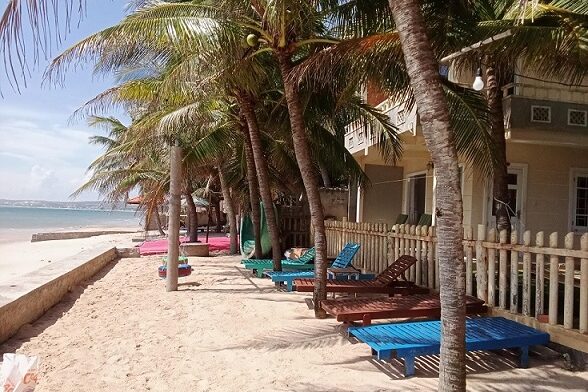
The Fairy Stream
The Fairy Stream is my favourite place in Mui Ne and probably a better experience than the sand dunes. In bare feet, you walk along the shallow, rippled stream bed, which feels nice for your toes. Be sure to go all the way to the end where you can stand under a waterfall to cool off.
It’s also a nice place just to hang out for a bit. Look out for the ‘Thai ice cream’ vendors and do yourself a favour by getting one and relaxing in the hammocks on the sand. The icecream is made from scratch through a process which involves scraping the liquid around a metal cold plate. Delicious.

We spent a good hour hanging out at a stall, drinking coffee, eating iecream, chatting to the guides and watching people go by.
As with all of these places the experience depends on timing and whether or not there are big tour groups coming through. I can also recommend the Hai Bang restaurant next door which does meals and cakes.

The road to Phan Thiet
The ride through to Phan Thiet eventually leaves Mui Ne behind, curving steadily up a hillside with nice views over Ham Tien beach, which has retained its sand.
Entering Phan Thiet oer the Ninh Chu bridge you’ll be greeted by the picturesque view of fishing boats nestled in the river.

Ancient Cham ruins
There is one more worthy stop here, the Cham ruins site Thap Po-Klong Garai, built in the 9th century when this area of Vietnam was part of the Champa kingdom. It’s now ranked as a ‘national relic’.
I very much enjoyed visiting the ruins and the view from the top of the hill is fantastic. This would be a great place to come just as the sun is going down.


I’ve also written a blog post about staying and eating in Phan Thiet, which you can read here
Read another post here about travelling with your bike on the train between Phan Thiet and Saigon (or vice-versa).


